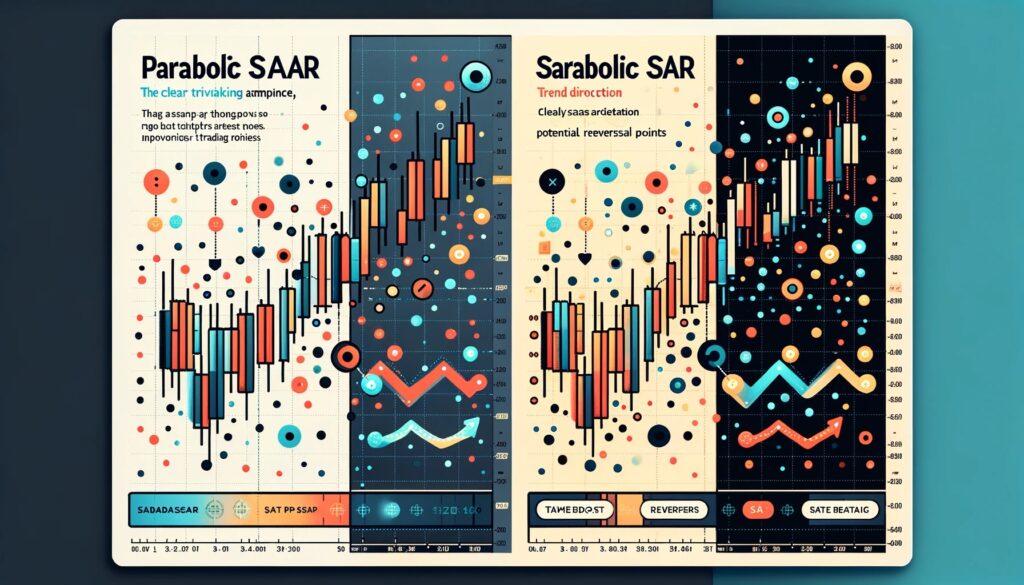The Parabolic Stop and Reverse (SAR) indicator is a versatile and powerful tool that has captivated the attention of Forex traders worldwide. Developed by the renowned technical analyst J. Welles Wilder Jr., the Parabolic SAR is designed to identify potential reversals in the market, making it an invaluable asset for traders looking to capitalize on every phase of market trends. This comprehensive guide delves into the intricacies of the Parabolic SAR, offering practical tips, strategies, and examples to help traders harness its full potential.
Decoding the Parabolic SAR
Exploring the Parabolic SAR
At its core, the Parabolic SAR is a trend-following indicator that appears on charts as a series of dots placed either above or below price bars. Its primary aim is to signal the current market momentum and forecast potential reversals in price direction. When dots are positioned below the price bars, it signifies an uptrend, encouraging a bullish outlook. Conversely, dots above the price bars indicate a downtrend, suggesting a bearish perspective.
The Science Behind the Indicator
The calculation behind the Parabolic SAR involves an acceleration factor, which adjusts as the trend develops, allowing the indicator to “accelerate” closer to the price. This mechanism ensures that the indicator is sensitive to price movements, tightening stop-and-reverse levels as trends progress. The parabolic shape formed by the dots during a strong trend gives the indicator its name, depicting the trajectory of a moving target in market trends.

Mastering the Parabolic SAR in Forex Trading
Trend Identification Made Simple
One of the Parabolic SAR’s standout features is its ability to clarify trend directions. Traders can confidently initiate buy orders when dots shift below the candlesticks, signaling strong bullish momentum. Similarly, the appearance of dots above the candlesticks warns of bearish momentum, guiding traders towards sell orders or caution in long positions.
Fine-tuning Entry and Exit Strategies
The Parabolic SAR excels in pinpointing optimal moments for market entry and exit, reducing guesswork for traders. A transition of dots from below to above the price bars (or vice versa) often indicates a potential trend reversal, serving as a cue for traders to adjust their positions accordingly, whether it’s taking profits or cutting losses.
Dynamic Stop-Loss Placement
Beyond signaling trend directions and reversals, the Parabolic SAR offers a strategic approach to risk management through dynamic stop-loss orders. Aligning stop-loss levels with the indicator’s dots can systematically limit potential losses, ensuring traders are positioned to exit trades if the market moves unfavorably.

Advanced Strategies for Utilizing the Parabolic SAR
Synergizing with Other Analytical Tools
While powerful on its own, the Parabolic SAR’s efficacy is magnified when combined with other technical analysis tools. Integrating it with moving averages, for instance, can offer confirmation of trend directions, enhancing the reliability of signals. Additionally, pairing the Parabolic SAR with oscillators like the RSI or MACD can aid in substantiating reversal signals, providing a more rounded analysis.
Optimizing Settings for Market Conditions
The default setting of the Parabolic SAR might not suit all trading styles or market environments. Traders should consider adjusting the acceleration factor and maximum step to fine-tune the indicator’s sensitivity. This customization allows for a tailored approach, ensuring the indicator’s settings are in harmony with the trader’s strategy and the prevailing market volatility.

Practical Application: Navigating Forex Markets
Case Study: Trading with the Parabolic SAR
Imagine the GBP/USD pair exhibiting a strong uptrend, with the Parabolic SAR dots comfortably positioned below the price bars. Suddenly, the dots flip above the price bars, signaling a potential downtrend. This signal prompts a cautious trader to secure profits by closing long positions. As the downtrend confirms, the trader then considers short positions, guided by the continued placement of dots above the price bars.
Conclusion
The Parabolic SAR is more than just a trend-following indicator; it’s a comprehensive tool that, when mastered, can significantly elevate a trader’s Forex strategy. By offering clear signals for trend direction, potential reversals, and providing a framework for dynamic stop-loss orders, it equips traders with the insights needed to navigate the complexities of the Forex market confidently. Successful application of the Parabolic SAR, however, requires a blend of strategic thinking, adjustment to market conditions, and integration with other technical analysis tools, ensuring traders are well-equipped to tackle the challenges and opportunities presented by the Forex market.

FAQs about the Parabolic SAR indicator
What is the Parabolic SAR?
The Parabolic SAR (Stop and Reverse) is a technical analysis tool designed to identify potential reversals in the market price direction of an asset. It is displayed as dots placed above or below the price on a chart, indicating the current trend’s direction. When the dots flip positions, moving from above the price to below it (or vice versa), it suggests a potential trend reversal.
How is the Parabolic SAR calculated?
The Parabolic SAR is calculated through a mathematical formula that takes into account the most recent extreme price (EP), the acceleration factor (AF), and the previous period’s SAR. The formula adjusts the rate at which the SAR point moves higher or lower, depending on the price movement’s strength, allowing it to “parabolically” catch up to prices.
How can I use the Parabolic SAR in my trading strategy?
The Parabolic SAR can be used in several ways:
- Trend Confirmation: Dots below the price indicate an uptrend, and dots above the price suggest a downtrend. This can help confirm the presence of a trend.
- Entry and Exit Points: A switch in the position of the dots, from below to above the price or vice versa, can signal potential entry or exit points based on trend reversals.
- Stop-Loss Placement: The dots can also serve as dynamic stop-loss levels, helping manage risk by signaling when it might be time to exit a trade if the trend reverses.
What are the limitations of the Parabolic SAR?
While the Parabolic SAR is valuable for identifying trend directions and potential reversals, it has limitations, especially in sideways or ranging markets where it can produce false signals. Its effectiveness is also dependent on the correct setting of the acceleration factor, which may need adjustment based on the volatility of the traded asset.
Can the Parabolic SAR be used for all time frames?
Yes, the Parabolic SAR can be applied to any time frame, from minute charts for day trading to daily or weekly charts for longer-term trend analysis. However, traders should be aware that its sensitivity changes with different time frames and may require adjustment of the acceleration factor to reduce false signals and improve accuracy.
How do I adjust the Parabolic SAR settings for better results?
Adjusting the acceleration factor and the maximum step can fine-tune the Parabolic SAR’s sensitivity to price movements. A lower acceleration factor will make the SAR less sensitive, reducing the number of reversal signals in a stable trend but potentially delaying the signal of a trend change. Conversely, a higher acceleration factor increases sensitivity but may lead to more false reversals. Experimenting with settings in a demo account based on your trading style and the asset’s volatility is advisable to find the optimal configuration.
Should the Parabolic SAR be used in isolation?
No, like most technical indicators, the Parabolic SAR should not be used in isolation for making trading decisions. Combining it with other indicators, such as moving averages for trend confirmation or oscillators like RSI for momentum, can provide a more comprehensive view of the market and help validate the signals it generates.





